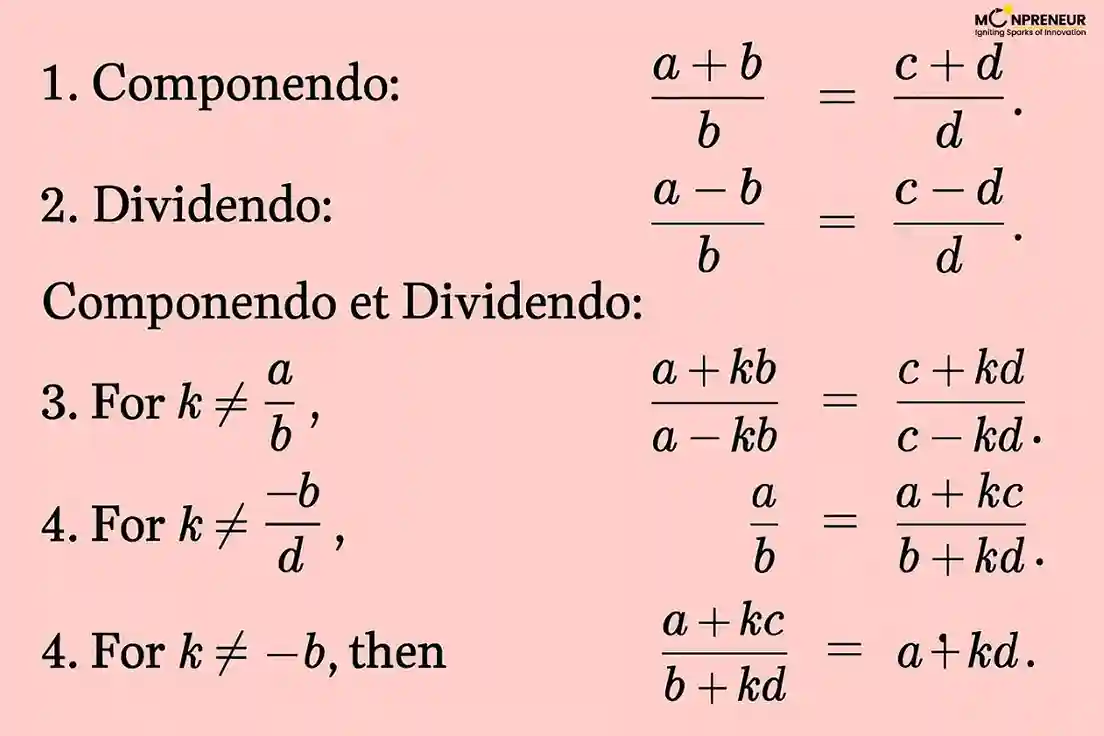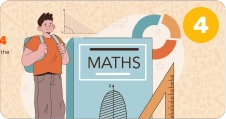Introduction
Componendo-dividendo rule: A theorem based on the topic of proportions permits a faster way to carry out the calculations and cut down the count of expansions required. It is helpful in situations involving equations with fractions or rational functions. The componendo and dividendo rule are used while studying ratios and proportions. If the ratio of any two given numbers is the same as the ratio of the other two numbers, then the ratios of the sum total of the numerator and denominator to the difference of the numerator and denominator of the two rational numbers are equal in nature.
What is the Componendo and Dividendo Rule?

In the concept of componendo, the fundamental rule is if a : b : : c : d then (a + b) : b : : (c + d) : d. It can be observed that it is required to add the denominator to the numerator in the given ratios and then they are equated. If the rule is used on the left side, then it should be used on the right side too.
In the dividendo rule, if a : b : : c : d then (a – b) : b : : (c – d) : d. It can be observed that it is required to subtract the denominator from the numerator in the given ratios. Everything else is the same as the componendo rule.
In the componendo and dividendo rule, if a : b : : c : d then (a + b) : (a – b) : : (c + d) : (c – d). If this rule is applied, then componendo and dividendo are used together.
Componendo Dividendo Rule Proof
Consider 4 quantities a, b, c and d such that a : b = c : d.
\(\displaystyle \frac{a}{b} = \frac{c}{d}\)
\(\displaystyle \frac{b}{a} = \frac{d}{c} \quad \text{[by invertendo]}\)
\(\displaystyle \frac{a+b}{b} = \frac{c+d}{d} \quad \text{[by componendo]}\)
\(\displaystyle \frac{a-b}{b} = \frac{c-d}{d} \quad \text{[by dividendo]}\)
\(\displaystyle \frac{a+b}{a-b} = \frac{c+d}{c-d}\)
\(\displaystyle (a+b) : (a-b) = (c+d) : (c-d)\)
So, it can be expressed as \(\displaystyle a : b = c : d \quad \text{and} \quad (a+b) : (a-b) = (c+d) : (c-d)\)
It is true that if the ratio of a to b = c to d, then the ratio of (a + b) to (a – b) is the same as (c + d) to (c – d). This is termed the componendo and dividendo rule.
Componendo Dividendo Rule – Solved Examples
If 2a – 3b = 0, then what is the value of (a – b) : (a + b)?
Convert the equation given to the proportion equation form.
\(\displaystyle 2a – 3b = 0\)
\(\displaystyle 2a = 3b\)
\(\displaystyle \frac{a}{b} = \frac{3}{2}\)
On adding 1 on both sides,
\(\displaystyle \frac{a}{b} + 1 = \frac{3}{2} + 1\)
\(\displaystyle \frac{a}{b} + 1 = \frac{3}{2} + 1\)
\(\displaystyle \frac{a+b}{b} = \frac{5}{2}\)
On subtracting 1 from both sides,
\(\displaystyle \frac{a-b}{b} = \frac{3-2}{2} = \frac{1}{2}\)
On dividing both the equations,
\(\displaystyle \frac{a-b}{a+b} = \frac{1}{5}\)
\(\displaystyle \text{If } \frac{a}{b} = \frac{c}{d}, \text{ then } \frac{a+b}{a-b} = \frac{c+d}{c-d}\)
\(\displaystyle \frac{a+b}{a-b}= \frac{16+3}{16-3} = \frac{19}{13}\)
Conclusion
The Componendo and Dividendo Rule is an important mathematical shortcut for solving ratio and proportion problems. It reduces the complexity of equations by transforming ratios into simpler forms. This rule is highly useful in algebra, trigonometry, and competitive exams where quick problem-solving is essential. By practicing solved examples, students can master this concept and apply it effectively in various mathematical problems.
Want to spark your child’s interest in math and boost their skills? Moonpreneur’s online math curriculum stands out because it engages kids with hands-on lessons, helps them apply math in real-life situations, and makes learning math exciting!
You can opt for our Advanced Math or Vedic Math+Mental Math courses. Our Math Quiz for grades 3rd, 4th, 5th, and 6th helps in further exciting and engaging in mathematics with hands-on lessons.
Related Blogs:
- How to Teach Adjacent Angles to Kids | Simple & Fun Guide
- What are Congruent Angles?
- Understanding Alternate Interior Angles
- What is the Area of Trapezoid?
- What is the Area of Parallelogram?
- Understanding the Geometry Regents: A Comprehensive Guide
- How to Prepare for the Geometry Regents: Study Plans & Practice
- The Art of Geometry: How to Draw an Equilateral Triangle Inside a Circle













